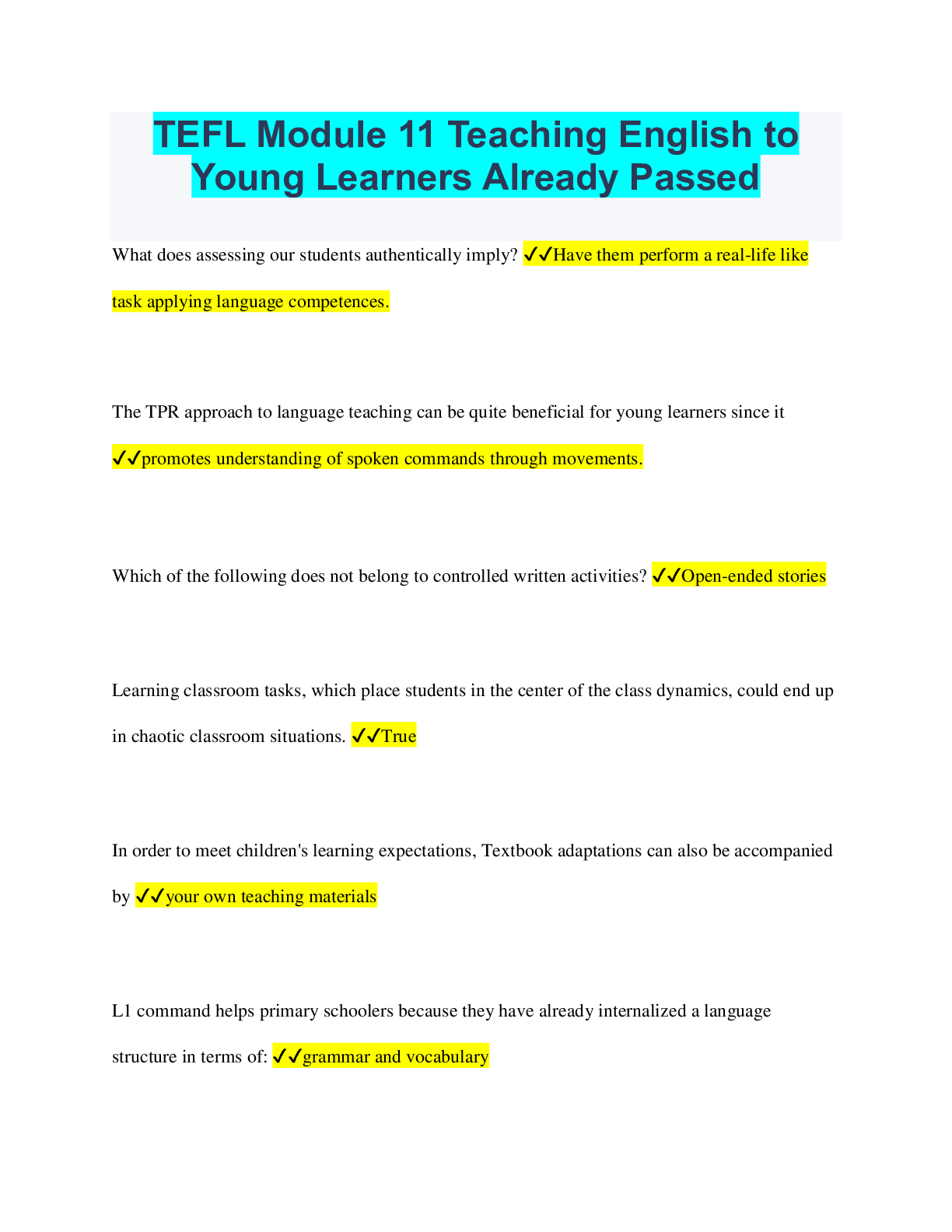Astronomy > QUESTIONS & ANSWERS > ASTRO 1 FINAL STUDY GUIDE (All)
ASTRO 1 FINAL STUDY GUIDE
Document Content and Description Below
ASTRO 1 FINAL STUDY GUIDE Place structures in order from smallest to largest: Earth, Sun, Galaxy, Universe. - Earth, Sun, Galaxy, Universe covert from one unit to another (conversion factor) - ... write conversion as a fraction, multiply it, cancel out any units that are on both the top and the bottom Light Year (ly) - the distance that light travels in one year (conversion factor: 1 ly = 9.5 x 10^12 km) Explain the difference between astronomy and astrology - astronomy is a science, astrology is strongly based on predictions Explain the difference between a rotation and a revolution - Rotation: a circular motion around a fixed position Revolution: a circular motion around an external object, not at the center of the body Identify what causes the daily apparent motion of the stars in our sky as viewed from earth - the rotation of the earth about its own axis state the period (time for a full cycle) of this apparent motion of stars in our sky - equator - 12 hours, pole - never, middle latitude - different times depending on the star given the current positions of stars in the sky, predict how their apperance will change as time passes (mins, hrs, days, months) - rise and set throughout the day Identify which direction the earth spins when viewed from the top (north) down: clockwise and counter clockwise - viewed from the north pole, the earth is rotating counter clockwise describe how apparent daily motion of stars changes with latitude on earth - higher the altitude - higher the altitude angle, lower the altitude angle - lower the altitude angle. equal relationship. solstice - suns path is highest and lowest in the sky; length of daylight is longest/shortest. approx dates june 21/dec 21, seasons summer and winter equniox - suns path is intermediate. 12 hours of daylight, 12 hours of dark. sun rises and sets due east and west. approx dates march 21/sept 21, seasons spring and fall Explain why seasons change and predict how seasons would be different if this factor were different - seasons are a result of the way th tilt of the earths axis causes sunlight to fall differently on earth at different times of the year. The suns path through the sky causes these seasonal changes. When the northern hemisphere is pointed toward the sun, it is June. When it pointed away from the sun, it is December. Describe how high the sun gets in the sky at different times of the year and at different latitudes, and explain the importance of this effect on seasons - When the suns path is high in the sky, light is more concentrated (more direct angle) AND the number of daylight hours is great (higher in the sky in summer) 8 main phases of the moon (in order) - New moon, waxing crescent moon (getting fuller), 1st quarter moon, waxing gibbous moon, full moon, waning gibbous moon, 3rd quarter moon, waning crescent moon (getting smaller) Identify the period (time) for a full cycle of moon phases - the moon goes through all 8 phases in one month. the moon will complete a full orbit in one month. Explain why the moon goes through phases - half the moon is illuminated by the sun but the portion of its illuminated half that we see from earth depends on the moons position in its orbit. Moon phases is directly related to the time it rises, reaches its highest point in the sky, and sets Describe what geometrical arrangement of sun, moon, and earth produces each of the two kinds of eclipses: solar and lunar - Lunar eclipse: when earth lies directly between the sun and the moon, so earths shadow falls on the moon Solar eclipse: when the moon lies directly between the sun and the earth, so the moons shadow falls on earth Explain why eclipses dont happen every month - the moons orbit is slightly inclined. to the plane of earths orbit around the sun, called the ecliptic plane. Because of their inclination, the moon spends most of its time either above or below the surface. list the 2 elements the sun is primarily composed of - hydrogen and helium list which elements are used/created in the fusion reactions in our sun - hydrogen and helium Explain why the sun shines - nuclear fusion in the core maintains both gravitational equilibrium between pressure and gravity and energy balance between thermal energy released in core and radiative energy lost from the suns surface Describe where fusion happens in a star - 2 hydrogen atoms fuse to become a helium atom state how long our sun will live - in about 5 billion years the sun will run out of hydrogen Name all components of the electromagnetic spectrum and put them in order by frequency - Radio waves, Microwaves, Infrared waves, Light, Ultraviolet waves (rays), X-rays, Gamma rays Explain what determines the "color" of light - determined by the frequency of the light wave (Red is lowest frequency, Violet is the highest) Which have a higher energy: high or low frequency waves - high energy: higher frequency and shorter wavelength low energy: lower frequency and longer wavelength Describe how the speed of light varies with wavelength - speed of light is directly proportional to wavelength. incr speed of light = incr wavelength Name all 8 planets in order - Mercury, Venus, Earth, Mars, Jupiter, Saturn, Uranus, Neptune All 4 terrestrial planets - Mercury, Venus, Earth, Mars All 4 jovian planets - Jupitar, Saturn, Uranus, Neptune Major characteristics of terrestrial planets - small, rocky, dense, no rings, few or no moons. close to the sun (<2 AU) Major characteristics of jovian planets - large, gaseous (low density), rings, many moons, far from the sun (~5-30 AU), widely spaced major characteristics of planets vs dwarf planets - the area surrounding each celestial body dwarf: has not cleared the area around its orbit planet: has cleared the area Define an astronomical unit - the mean distance from the center of the sun to the center of the earth Explain the difference between the greenhouse effect and global warming - Greenhouse effect: how heat is retained by the atomosphere due to the greenhouse gases Global warming: an increase in average annual temperatures across the globe Differences between the Kupier Belt and Asteroid Belt - Kupier Belt: larger in size and more massive (has more objects), the objects are composed largely of various ices Asteroid Belt: objects are composed largely of silicates (rocks) and metals Similarities between the Kupier Belt and Asteroid Belt - they are both a region of leftovers from the solar system's early history, and have also been shaped by a giant planet, although it's more of a thick disk then a thin belt Explain the difference between comets and metors - Comet: a body of ice, rock and dust that can be several miles in diameter and orbits the sun Metor: a meteroid that enters the earth's atmosphere and vaporizes. "shooting star" Apparent brightness, luminosity, distance equation - Ab = L/4(3.14)d^2 Ab - Apparent brightness L - Luminosity D - Distance Parallax/distance equation - d = 1/p D - Distance P - Parallax Hertzprung-Russell diagram - a graph of L vs. T only for many stars. Not a picture of stars. Classifies stars according to their luminosity, spectral type, color, temperature, and evolutionary stage Identify where high and low mass stars reside of the Main Sequence, and explain why more massive stars have shorter lifetimes - Mass vaires along sequence (larger mass - larger luminosity). The more massive the star, the faster it burns its fuel supply. The most massive star can burn out and explode in a supernova after only a few million years of fusion Describe how the luminosity of a star depends on both radius and temperature - L is proportional to R^2T^2 A hotter star is more Luminous than a cooler one of the same radius A bigger star is more luminous than a smaller one of the same temperature 3 Basic Kinds of Spectra - continuous (thermal or blackbody), emission, absorption Kinds of Spectra - Continuous (thermal): comes from all dense opaque materials (solids or dense gases), hotter objects appear Emission: comes from diffuse gas Absorption: Individual atoms emit/abosrb specific wavelength (or frequency) Wien's Law - Peak wavelength = .0029(m)(k)/T Explain why different masses of stars are different colors - depends on their chemical compositions, their respective sizes and their temperatures. Overtimes as these characteristics change many will darken and become redder, while others will explode magnificently. What color high-mass stars appear to your eyes - high mass star (mass greater than 3x the mass of the sun): the largest, hottest and brightest main sequence stars and blue, blue-white, or white in color. Use up their hydrogen fuel very rapidly and consequently have short lives What color low-mass stars appear to your eyes - low mass star (mass less than half the mass of the sun): smallest, coolest, dimmest main sequence stars and orange, red, or brown in color. Use up their hydrogen fuel very slowly and consequently have long lives Composition of Matter - Atoms Each with electrons surrounding a small nucleus, which contains protons Photon - A particle representing a quantum of light or other electromagnetic radiation. Carries energy proportional to the raditation frequency but has zero rest mass Electron - A stable subatomic particle with a charge of negative electricity. found in all atoms and acting as the primary carrier of electricity in solids Protons - a stable subatomic particle occurring in all atomic nuclei, with a positive electric charge equal in magnitude to that of an electron, but of opposite sign. Atom - The basic units of matter and the defining structure of elements Element - Each of more than one hundred substances that cannot be chemically interconverted or broken down into simplier substances and are primary constituents of matter Each element is distinguished by its atomic number (the number of protons in the nuclei of atoms) Blueshift - Waves compressed to shorter ("bluer") wavelengths; happens when source of observer is moving towards Redshift - Waves stretched to longer ("redder") wavelengths, happens when source of observer is moving away Doppler Shift - Spectra "shift" (or change wavelength) due to Doppler Effect Describe how gravity acts between objects - More massive objects will attract each other with a greater gravitational force. As the mass of objects increase, the force of gravitational attraction also increases Law of Universal Gravitation - states that gravitational force between 2 objects is directly proportional to the product of their masses and inversly propotional to the square of the distance between their centers Explain what causes the phenomenon of "weightlessness" - earth-orbiting astronauts are weightless for the same reasons that riders of free-falling elevators are weightless. no external force pushing or pulling upon their body (gravity is the only force acting upon their body) Describe how weightlessness and freefall are related to orbits - the object with more mass will always be closer to the middle (smaller orbits) List 3 characteristics that uniquely define a (Main Sequence) star - glowing ball of hot gas, powered by core nuclear fusion, in gravitational equilibrium List the stages that a low mass star will go through in its evolution after being on a Main Sequence - core: shrinking (T increasing L increasing) other layers: expands (L increasing T decreasing) Red Giant Fusing shells of H-He-C (star death) Planetary Nebula (outer layers ejected gently) Leaving behind - white dwarf (small, not faint, cools forever) List the stages that a high-mass star will go through in its evolution after being on the Main Sequence - core: shrinking (T increasing L increasing) outer layers: expands (L increasing T decreasing) Red Supergiant Fusing shells of H-He-C...-iron (star death) Supernova (outer layers ejected violently) leaving behind - neutron star (sometimes collapse to: Black Hole) Identify what event marks the end of a star's main sequence lifetime - Once there is insufficent hydrgoen in its core to fuse into helium, a star ends its life on the Main Sequence and moves on to become a red giant Red Giant - a very large star of high luminosity and low surface temperature. Thought to be in a late stage of evolution when no hydrogen remains in the core to fuel nuclear fusion Red Supergiants - Are stars with a supergiant luminosity class of spectral type k or m. Largest star in the universe in terms of volume, although they are not the most massive or luminous White Dwarf - A small, very dense star that is typically the size of a planet. Formed when a low- mass star has exhausted all of its central nuclear fuel and lost its outer layers as a planetary nebula Planetary Nebula - A transitory phase as a red giants outer layer floats away, a neutron star remains at the core of the supernova remnant Explain where the different elements in your body and the world around you were created - the elements formed in these stages range from oxygen through to iron. During a supernova, the star releases very large amounts of energy as well as neutrons, which allows elements heavier than iron, such as uranium and gold, to be produced Explain how a white dwarfs observable properties (specifically Luminosity & temp) change over billions of years if it is left alone - the temperature and luminosity will diminish Pulsar - A celestial object, thought to be a rapidly rotating neutron star, emits regular pusles of radio waves and other electromagnetic radiation at rates of up to one thousand pulses per second. Rank neutron stars, black holes, main sequence stars, planets and white dwarfs in order of increasing density - Main sequence stars, planets, white dwarfs, neutron stars, black hole Black hole - An object whose gravity is so great that no light can escape Schwarzschild radius - the distance from the center of an object such that, if all the mass were compressed within that region, the escape speed would equal the speed of light Explain what would happen to the earths orbit if the sun turned into a black hole (bh) - the earth would be unaffected - it would continue in its orbit as though nothing had happened Escape velocity - the minimum velocity needed to escape a gravitational feild Whats at the center of our galaxy - a black hole how does the black hole at the center of our galaxy affect the galaxy - it has little effect on the rest of the stars very close to it - if it were removed, for instance, it would have very little effect on the overall shape of the galaxy because it composes such a small mass relative to the size of our galaxy. Stars orbit the center of mass, which wouldn't change if the BH were gone size of the galaxy - very large, the milky ways 120,000 light years across movement of the sun in the galaxy - stars orbit the center mass of the galaxy T/F: Galaxies are mostly empty space - True; there is a lot of empty space between stars in the galaxy Explain why gravity dominates over the competing effect of expansion within galaxy clusters - galaxy clusters are gravitationally bound together over the competing effect of expansion Explain how we can know what the universe/galaxies looked like when they were younger - Lookback time because of the infinte speed of light, [Show More]
Last updated: 2 years ago
Preview 1 out of 20 pages
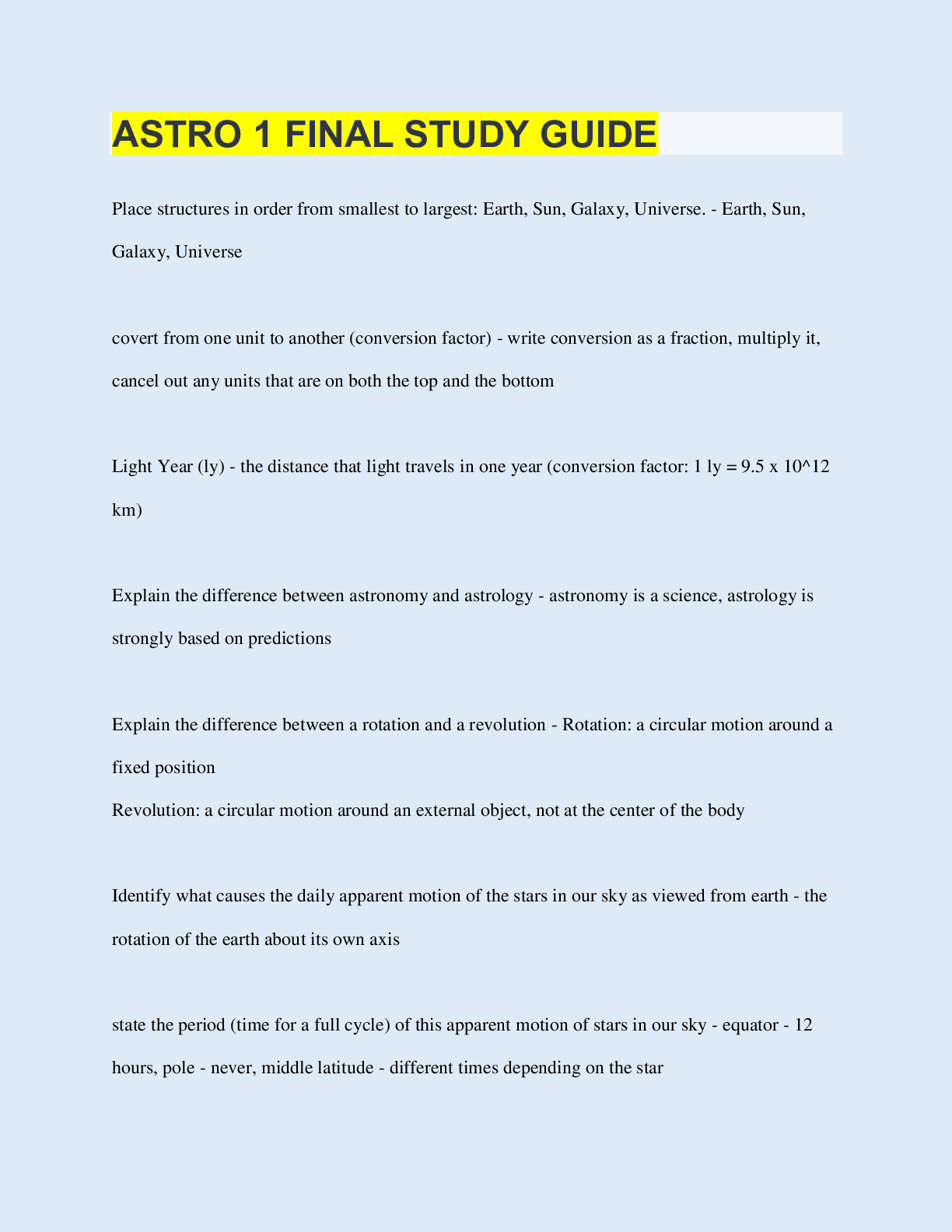
Buy this document to get the full access instantly
Instant Download Access after purchase
Buy NowInstant download
We Accept:

Reviews( 0 )
$10.00
Can't find what you want? Try our AI powered Search
Document information
Connected school, study & course
About the document
Uploaded On
Jan 26, 2023
Number of pages
20
Written in
All
Additional information
This document has been written for:
Uploaded
Jan 26, 2023
Downloads
0
Views
208


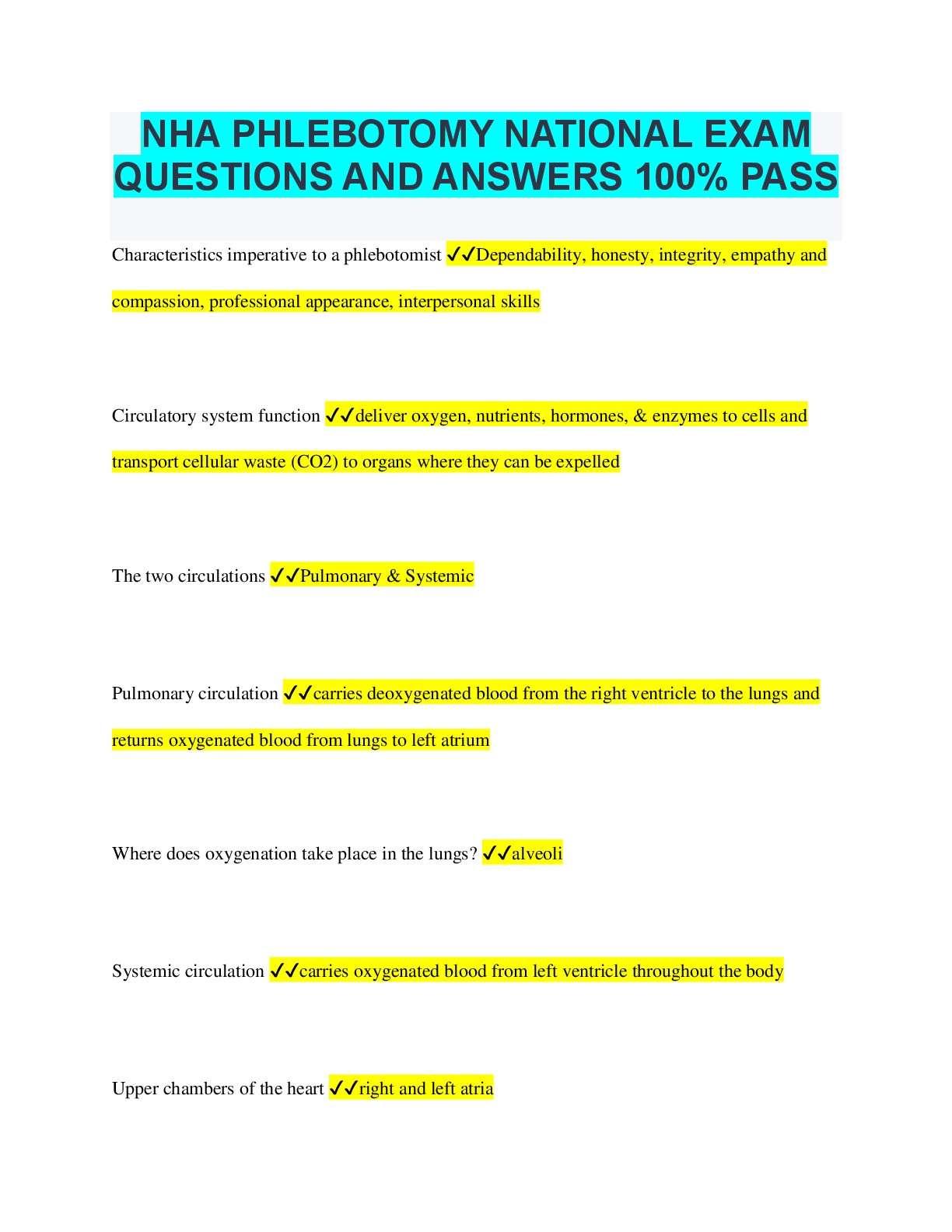




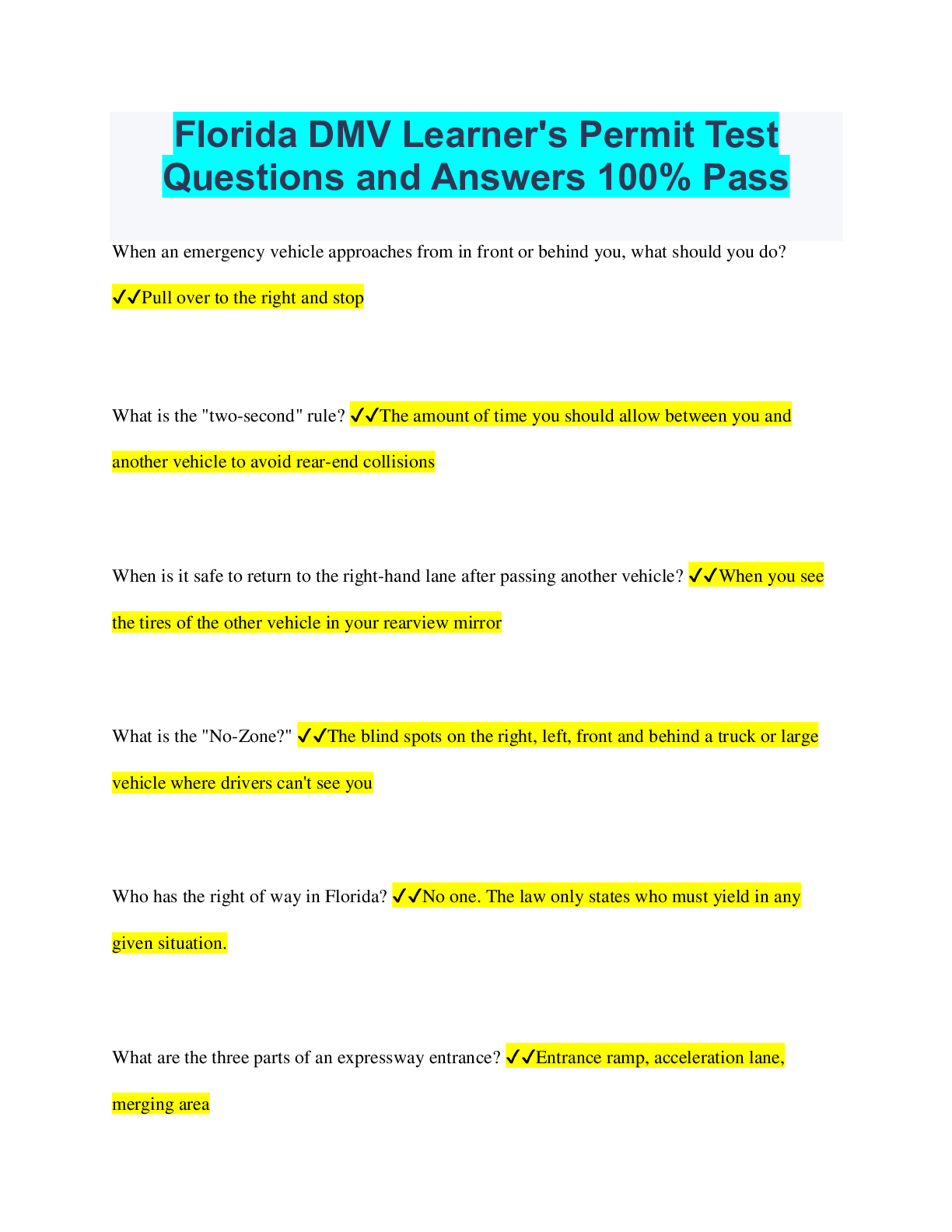
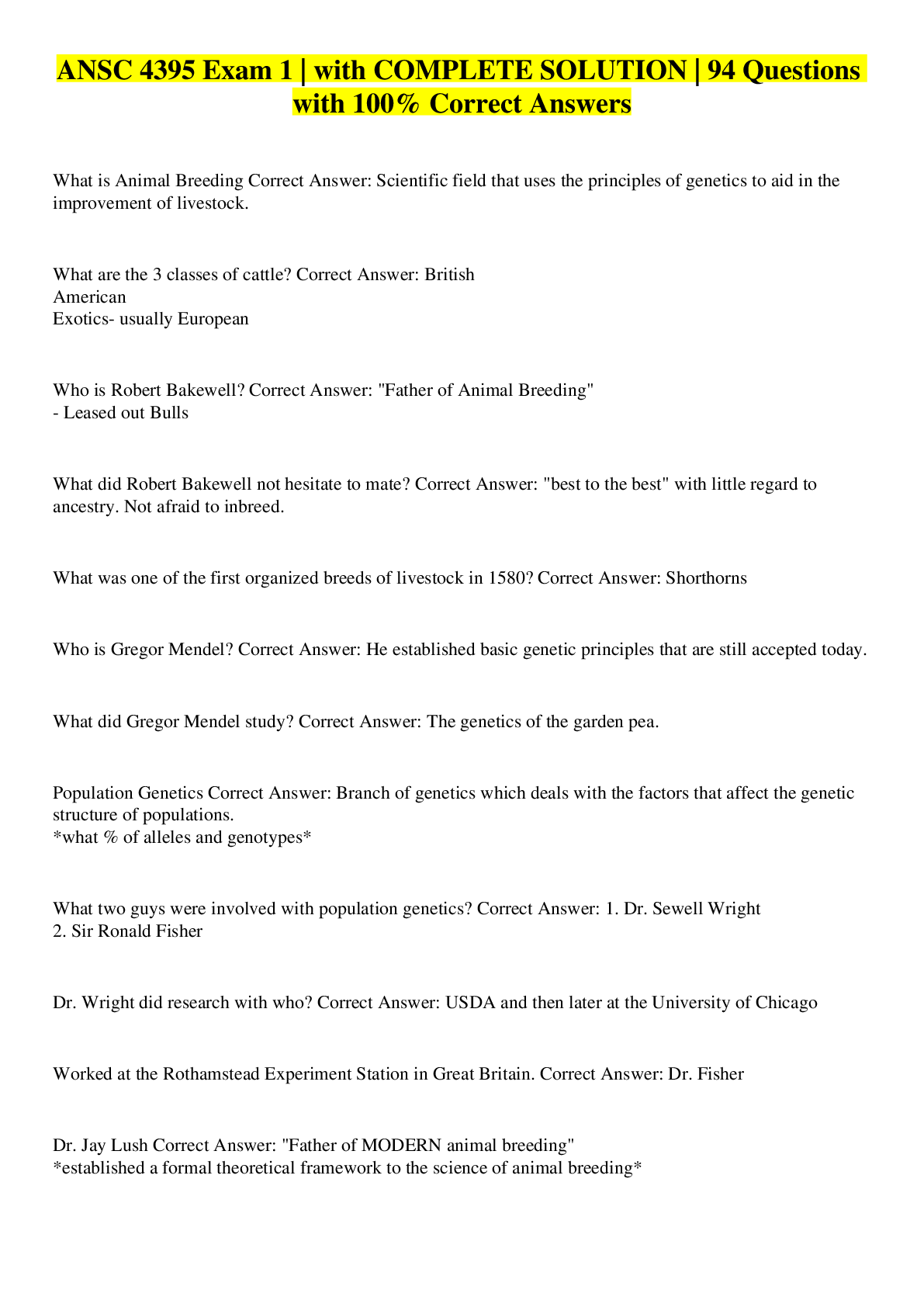

.png)

